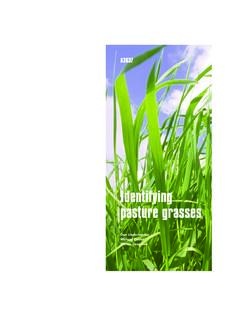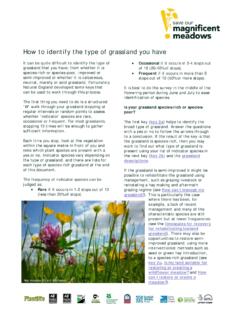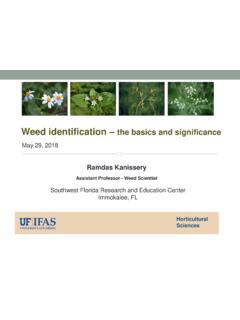Transcription of National Vegetation Classification - field guide to mires ...
1 National Vegetation Classification field guide tomires and heathsNational Vegetation Classification : field guide to mires and heathsCover photograph:Studland Heath National Nature Reserve, Dorset. English NatureNational Vegetation Classification : field guide to mires and heathsT. Elkington, N. Dayton, Jackson and StrachanJoint Nature Conservation CommitteeMonkstone HouseCity RoadPeterboroughPE1 1 JYUKISBN 1 86107 526 X JNCC Vegetation Classification7 mires and heaths: scope of this guide7 Using this keys to mire community descriptions and sub-community keys19M1 Sphagnum auriculatumbog pool community19M2 Sphagnum cuspidatum/recurvumbog pool community20M3 Eriophorum angustifoliumbog pool community21M4 Carex rostrata Sphagnum recurvummire22M5 Carex rostrata Sphagnum squarrosummire23M6 Carex echinata Sphagnum recurvum/auriculatummire24M7 Carex curta Sphagnum russowiimire26M8 Carex rostrata Sphagnum warnstorfiimire27M9 Carex rostrata Calliergon cuspidatum/giganteummire28M10 Carex dioica Pinguicula vulgarismire30M11 Carex demissa Saxifraga aizoidesmire32M12 Carex saxatilismire33M13 Schoenus nigricans Juncus subnodulosusmire34M14 Schoenus nigricans Narthecium ossifragummire34M15 Scirpus cespitosus Erica tetralixwet heath36M16 Erica tetralix Sphagnum compactumwet heath38M17 Scirpus cespitosus Eriophorum vaginatumblanket mire40M18 Erica tetralix Sphagnum papillosumraised & blanket
2 Mire42M19 Calluna vulgaris Eriophorum vaginatumblanket mire44M20 Eriophorum vaginatumblanket & raised mire46M21 Narthecium ossifragum Sphagnum papillosumvalley mire47M22 Juncus subnodulosus Cirsium palustrefen-meadow48M23 Juncus effusus/acutiflorus Galium palustrerush-pasture50M24 Molinia caerulea Cirsium dissectumfen-meadow52M25 Molinia caerulea Potentilla erectamire54M26 Molinia caerulea Crepis paludosamire56M27 Filipendula ulmaria Angelica sylvestrismire58M28 Iris pseudacorus Filipendula ulmariamire60M29 Hypericum elodes Potamogeton polygonifoliussoakway62M30 Related Vegetation of seasonally inundated habitats62M31 Anthelia julacea Sphagnum auriculatumspring63M32 Philonotis fontana Saxifraga stellarisspring64 Contents6M33 Pohlia wahlenbergii demissa Koenigia islandicaflush66M35 Ranunculus omiophyllus Montia fontanarill67M36 Lowland springs and streambanks of shaded situations67M37 Cratoneuron commutatum Festuca rubraspring68M38 Cratoneuron commutatum Carex keys to heath community descriptions and sub-community keys76H1 Calluna vulgaris Festuca ovinaheath76H2 Calluna vulgaris Ulex minorheath78H3 Ulex minor Agrostis curtisiiheath80H4 Ulex gallii Agrostis curtisiiheath82H5 Erica vagans Schoenus nigricansheath84H6 Erica vagans Ulex europaeusheath86H7 Calluna vulgaris Scilla vernaheath88H8 Calluna vulgaris Ulex galliiheath90H9 Calluna vulgaris Deschampsia flexuosaheath92H10 Calluna vulgaris Erica cinereaheath94H11 Calluna vulgaris Carex arenariaheath96H12 Calluna vulgaris Vaccinium myrtillusheath98H13 Calluna vulgaris Cladonia arbusculaheath100H14 Calluna vulgaris Racomitrium lanuginosumheath102H15 Calluna vulgaris Juniperus communis vulgaris Arctostaphylos uva-ursiheath104H17 Calluna vulgaris Arctostaphylos alpinusheath106H18 Vaccinium myrtillus Deschampsia flexuosaheath108H19 Vaccinium myrtillus Cladonia
3 Arbusculaheath110H20 Vaccinium myrtillus Racomitrium lanuginosumheath112H21 Calluna vulgaris Vaccinium myrtillus Sphagnum capillifoliumheath114H22 Vaccinium myrtillus Rubus chamaemorusheath116 National Vegetation Classification71 IntroductionSince its development in the 1980s, the NationalVegetation Classification (NVC) has become thestandard Classification used for describing vegeta-tion in Britain. Whereas many other classificationsare restricted to particular types of Vegetation , theNVC aims to describe all the Vegetation of GreatBritain. This means that it is possible to analyse,and map, a complex site, composed of severalhabitat types ( woodland, scrub, heathland andbog) using the same Classification system. The NVC is a phytosociological Classification ,classifying Vegetation solely on the basis of theplant species of which it is composed. The result-ing communities can usually be correlated to otherfactors, such as geology and soils, climate, waterchemistry and management; but the plant speciesalone are used to assign the Vegetation to a NVC breaks down each broad vegetationtype ( heath, mire, woodland) into communities,designated by a number and name ( H4 Ulex gal-lii Agrostis curtisii heath, M10 Carex dioica Pinguicula vulgaris mire, W4 Betula pubescens Molinia caerulea woodland).
4 Many (but not all) ofthese communities contain two or more sub-com-munities, designated by a letter ( H4b Ulex gal-lii Agrostis curtisii heath, Festuca ovina sub-com-munity). Sub-communities in a few cases are fur-ther divided into variants ( M10bi and ii).The second volume of British Plant Communitieswas published in 1991 (Rodwell 1991a). It providesa detailed account of 38 mire communities and 22heath communities, giving information on theircomposition, structure and distribution, theiraffinities to other types of Vegetation , both inBritain and on the Continent, and the relation ofthe communities described within the NVC tothose previously described by other authors. Thescope of this field guide is identical to that ofVolume number of Vegetation types which might alsobe considered as mires or heaths are describedin other volumes of British Plant Communities,and so are not included here.
5 Aquatic, swamp andtall-herb fen communities can be found in Volume4 (Rodwell 1995), whilst inundation communities, mires and heaths: scope of this guidedune slack communities and Epilobium hirsutumstands are described in Volume 5 (Rodwell 2000). Grass heaths , Dryas heaths and related lichenand bryophyte dominated Vegetation are includedin Volume 3 (Rodwell 1992), as are certain wetgrasslands. Volume 1 (Rodwell 1991b) encompasseswet woodland and scrub Vegetation . Companionguides to volumes 1 and 3 have also been pub-lished by JNCC (Hall et al. 2001; Cooper 1997).Users of this guide should also note that most wet heath Vegetation is described in the NVCwith the mires rather than the heaths (as M15 Scirpus cespitosus Erica tetralix wet heath andM16 Erica tetralix Sphagnum compactum wetheath), because of its floristic affinities. Helpfulinsight into the floristic relationships of NVCtypes can be gained from the PhytosociologicalConspectus in Volume 5 of British PlantCommunities.
6 This places all NVC communitieswithin a hierarchical framework of European gaps in coverage of the NVC have beenidentified at community and sub-community levelsubsequent to the publication of British PlantCommunities. These include several mire andheath types, as outlined in JNCC Report No. 302 Review of coverage of the National VegetationClassification (Rodwell et al. 2000). No attempthas been made to incorporate these here, pendingfurther analysis and formal summary descriptions provided here arederived directly from the full accounts preparedby John Rodwell, but are in no way a substitute forthem. Rather they are intended as an aide-mem-oire to assist surveyors in the field or for anyoneelse wishing to familiarise themselves with theoverall scheme of Classification for mires andheaths. Anyone who uses this book should alwayscheck their results against the frequency tablesand full descriptions for each community inVolume 2 of British Plant Communities.
7 Thedescriptions are not intended to take account ofthe results of recent survey work undertaken bythe three country agencies (Countryside Councilfor Wales, English Nature, Scottish NaturalHeritage) which may help circumscribe some ofthe communities more tightly and improve ourunderstanding of community this guide8A series of dendrograms have been produced toshow the broad floristic relationships between themain communities and between the sub-commu-nities for each community where these dendrograms are only intended as guidesand should not be followed slavishly. Details ofvariants, if indicated, can be found in Volume 2 ofBritish Plant amount of any particular species isreferred to both in terms of its frequency andabundance. Frequency refers to how often a plantis found in moving from one sample or vegetationto the next, irrespective of how much of thatspecies is present in each sample.
8 This is sum-marised in the published tables as classes denotedby the Roman numerals I to V: 1-20% frequency(that is, up to one sample in five) = I, 21-40% = II,41-60% = III, 61-80% = IV, and 81-100% = V. Thesummary descriptions follow the usual conven-tion of referring to species of frequency classes IVand V in a particular community as its constants,with those species of class III as common or fre-quent, of class II as occasional and of class I asscarce or rare. The term abundance , on the otherhand, is used to describe how much of a plant ispresent in a sample, irrespective of how frequentor rare it is among the samples. It is summarisedin the published tables as bracketed numbers forthe Domin ranges, and is referred to in the texthere, as in the published descriptions, using suchterms as dominant, abundant, frequent and nomenclature for plant species used inBritish Plant Communities has been followed inthis publication for consistency.
9 Botanists morefamiliar with Stace s New flora of the British Isles(Stace 1997) may not recognise names such as(Stace equivalent in brackets): Scirpus cespitosus(Trichophorum cespitosum),Carex demissa (C. viridula ssp. oedocarpa),C. lepidocarpa (C. viridula ssp. brachyrrhyncha) andSilene vul-garis maritima (S. uniflora). Amongst cryptogams,the common lichen of heaths and bogs referred tohere as Cladonia impexa is now generally knownasC. , E A (1997) Summary descriptions of Nat-ional Vegetation Classification grassland andmontane communities. Joint Nature Con-servation Committee, Peterborough (UK NatureConservation No. 14).Hall, J E, Kirby, K J and Whitbread, A M (2001) National Vegetation Classification : field guideto woodland. Joint Nature Conservation Com-mittee, , J S, (ed) (1991a) British Plant Commun-ities. Volume 2. mires and heaths. CambridgeUniversity Press, , J S, (ed) (1991b) British Plant Commun-ities.
10 Volume 1. Woodlands and scrub. CambridgeUniversity Press, , J S, (ed) (1992) British Plant Commun-ities. Volume 3. Grasslands and montane com-munities. Cambridge University Press, , J S, (ed) (1995)British Plant Commun-ities. Volume 4. Aquatic communities, swampsand tall-herb fens. Cambridge University Press, , J S, (ed) (2000)British Plant Commun-ities. Volume 5. Maritime communities andvegetation of open habitats. Cambridge University Press, , J S, Dring, J C, Averis, A B G, Proctor, MC F, Malloch, A J C, Schamin e, J N J andDargie, T C D (2000) Review of coverage of theNational Vegetation Classification . JNCC ReportNo. 302. Stace, C (1997) New flora of the British Isles. 2nded. Cambridge University Press, Dendrogram keys to mire communitiesA Key to mires1. or very frequent in the Vegetation , either continuous or Sub-shrubsnot constant;though Callunavulgarisand/orErica tetralixmay be present atlow abundance.










